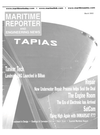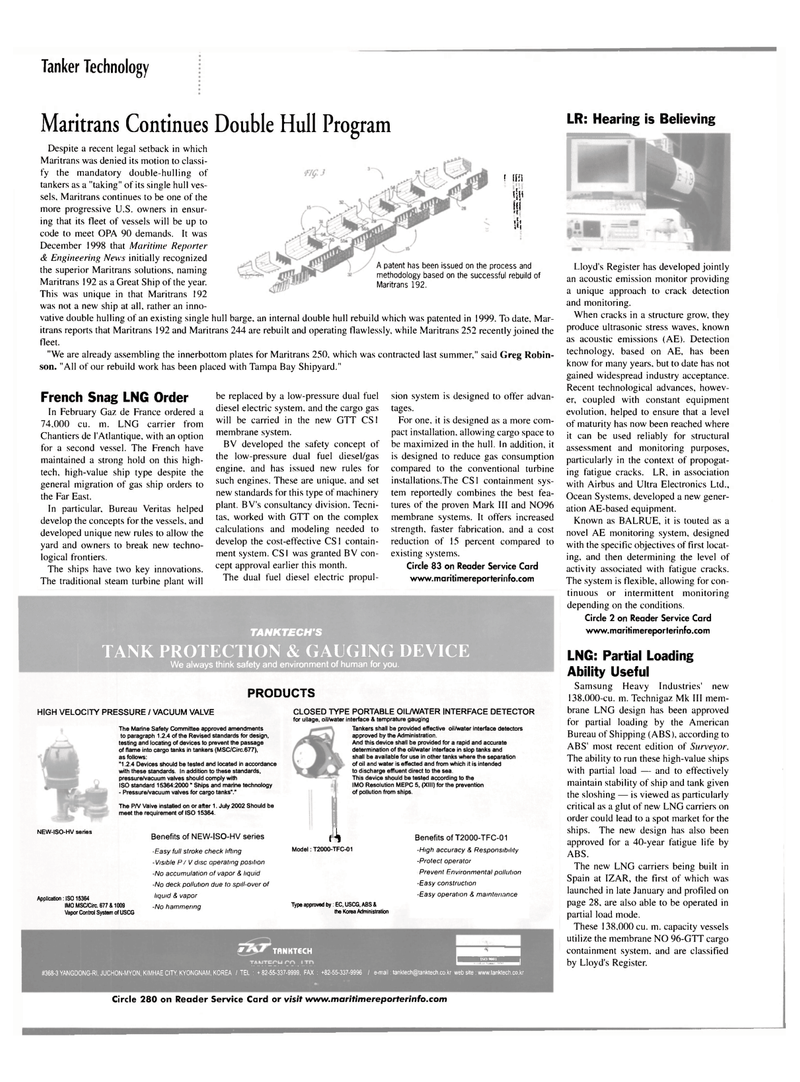
Page 32: of Maritime Reporter Magazine (March 2002)
Read this page in Pdf, Flash or Html5 edition of March 2002 Maritime Reporter Magazine
Tanker Technology ! S
Maritrans Continues Double Hull Program
Despite a recent legal setback in which
Maritrans was denied its motion to classi- fy the mandatory double-hulling of tankers as a "taking" of its single hull ves- sels, Maritrans continues to be one of the more progressive U.S. owners in ensur- ing that its fleet of vessels will be up to code to meet OPA 90 demands. It was
December 1998 that Maritime Reporter & Engineering News initially recognized the superior Maritrans solutions, naming
Maritrans 192 as a Great Ship of the year.
This was unique in that Maritrans 192 was not a new ship at all, rather an inno- vative double hulling of an existing single hull barge, an internal double hull rebuild which was patented in 1999. To date, Mar- itrans reports that Maritrans 192 and Maritrans 244 are rebuilt and operating flawlessly, while Maritrans 252 recently joined the fleet. "We are already assembling the innerbottom plates for Maritrans 250. which was contracted last summer," said Greg Robin- son. "All of our rebuild work has been placed with Tampa Bay Shipyard." m [ili !!' it:
A patent has been issued on the process and methodology based on the successful rebuild of
Maritrans 192.
French Snag LNG Order
In February Gaz de France ordered a 74,000 cu. m. LNG carrier from
Chantiers de l'Atlantique, with an option for a second vessel. The French have maintained a strong hold on this high- tech, high-value ship type despite the general migration of gas ship orders to the Far East.
In particular. Bureau Veritas helped develop the concepts for the vessels, and developed unique new rules to allow the yard and owners to break new techno- logical frontiers.
The ships have two key innovations.
The traditional steam turbine plant will
HIGH VELOCITY PRESSURE / VACUUM VALVE be replaced by a low-pressure dual fuel diesel electric system, and the cargo gas will be carried in the new GTT CS1 membrane system.
BV developed the safety concept of the low-pressure dual fuel diesel/gas engine, and has issued new rules for such engines. These are unique, and set new standards for this type of machinery plant. BV's consultancy division. Tecni- tas, worked with GTT on the complex calculations and modeling needed to develop the cost-effective CS1 contain- ment system. CSI was granted BV con- cept approval earlier this month.
The dual fuel diesel electric propul- sion system is designed to offer advan- tages.
For one, it is designed as a more com- pact installation, allowing cargo space to be maximized in the hull. In addition, it is designed to reduce gas consumption compared to the conventional turbine installations.The CSI containment sys- tem reportedly combines the best fea- tures of the proven Mark III and N096 membrane systems. It offers increased strength, faster fabrication, and a cost reduction of 15 percent compared to existing systems.
Circle 83 on Reader Service Card www.maritimereporterinfo.com
LR: Hearing is Believing
Lloyd's Register has developed jointly an acoustic emission monitor providing a unique approach to crack detection and monitoring.
When cracks in a structure grow, they produce ultrasonic stress waves, known as acoustic emissions (AE). Detection technology, based on AE, has been know for many years, but to date has not gained widespread industry acceptance.
Recent technological advances, howev- er, coupled with constant equipment evolution, helped to ensure that a level of maturity has now been reached where it can be used reliably for structural assessment and monitoring purposes, particularly in the context of propogat- ing fatigue cracks. LR, in association with Airbus and Ultra Electronics Ltd.,
Ocean Systems, developed a new gener- ation AE-based equipment.
Known as BALRUE, it is touted as a novel AE monitoring system, designed with the specific objectives of first locat- ing, and then determining the level of activity associated with fatigue cracks.
The system is flexible, allowing for con- tinuous or intermittent monitoring depending on the conditions.
Circle 2 on Reader Service Card www.maritimereporlerinfo.com
LNG: Partial Loading
Ability Useful
Samsung Heavy Industries' new 138,000-cu. m. Technigaz Mk III mem- brane LNG design has been approved for partial loading by the American
Bureau of Shipping (ABS), according to
ABS' most recent edition of Surveyor.
The ability to run these high-value ships with partial load — and to effectively maintain stability of ship and tank given the sloshing — is viewed as particularly critical as a glut of new LNG carriers on order could lead to a spot market for the ships. The new design has also been approved for a 40-year fatigue life by
ABS.
The new LNG carriers being built in
Spain at IZAR, the first of which was launched in late January and profiled on page 28, are also able to be operated in partial load mode.
These 138,000 cu. m. capacity vessels utilize the membrane NO 96-GTT cargo containment system, and are classified by Lloyd's Register.
TANKTECH'S
TANK PROTECTION & GAUGING DEVICE
We always think safety and environment of human for you.
PRODUCTS
CLOSED TYPE PORTABLE OIL/WATER INTERFACE DETECTOR for ullage, oil/water interface & temprature gauging
Tankers shall be provided effective oil/water interface detectors approved by the Administration.
And this device shall be provided for a rapid and accurate determination of the oil/water interface in slop tanks and shall be available for use in other tanks where the separation of oil and water is effected and from which it is intended to discharge effluent direct to the sea.
This device should be tested according to the
IMO Resolution MEPC 5, (XIII) for the prevention of pollution from ships.
A
Model: T2000-TFC-01
Benefits of T2000-TFC-01 -High accuracy & Responsibility -Protect operator
Prevent Environmental pollution
-Easy construction
-Easy operation
Type approved by: EC, USCG, ABS & the Korea Administration
The Marine Safety Committee approved amendments to paragraph 1.2.4 of the Revised standards for design, testing and locating of devices to prevent the passage of flame into cargo tanks in tankers (MSC/Circ.677), as follows: "1.2.4 Devices should be tested and located in accordance with these standards. In addition to these standards, pressure/vacuum valves should comply with
ISO standard 15364:2000" Ships and marine technology - Pressure/vacuum valves for cargo tanks"."
The P/V Valve installed on or after 1. July 2002 Should be meet the requirement of ISO 15364.
NEW-ISO-HV series Benefits of NEW-ISO-HV series
Application: ISO 15364
IMO MSC/Circ. 677 & 1009
Vapor Control System of USCG •Easy ful stroke check lifting -Visible P/V disc operating position -No accumulation of vapor & liquid -No deck pollution due to spill-over of liquid & vapor -No hammering *THNKT6CH iHKHH
I ISO •MO I I I #368-3 YANGD0NG-RI, JUCHON-MYON, KIMHAE CITY, KYONGNAM, KOREA / TEL : +82-55-337-9999, FAX : +82-55-337-9996 / e-mail: tanklech§tanktech.co.kr web site: www.tanktech.co.kr
Circle 280 on Reader Service Card or visit www.maritimereporterinfo.com

 31
31

 33
33
